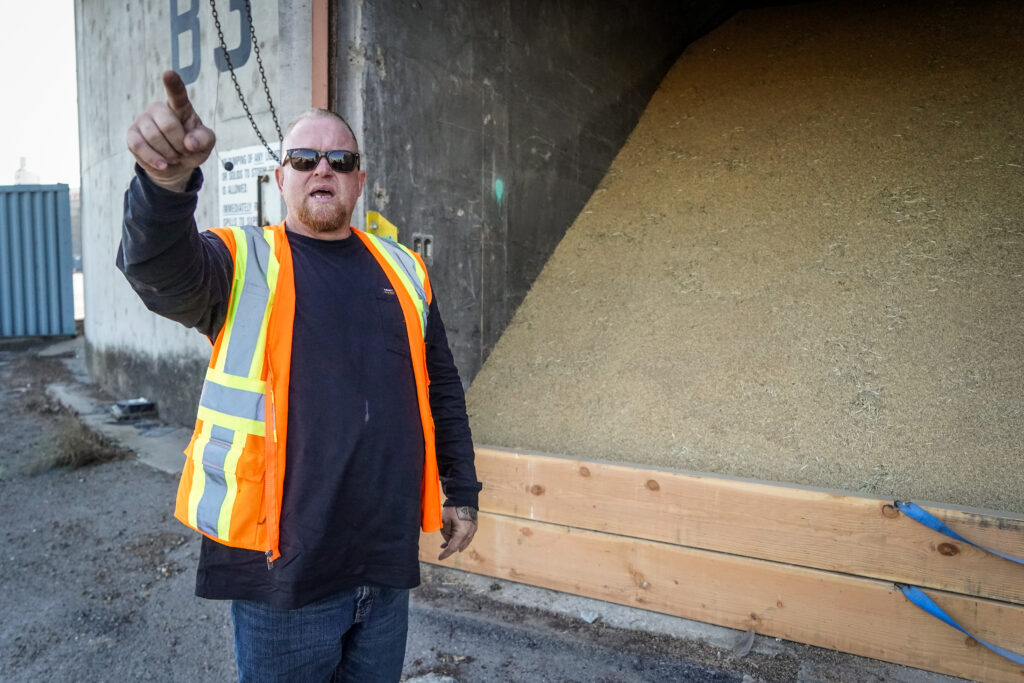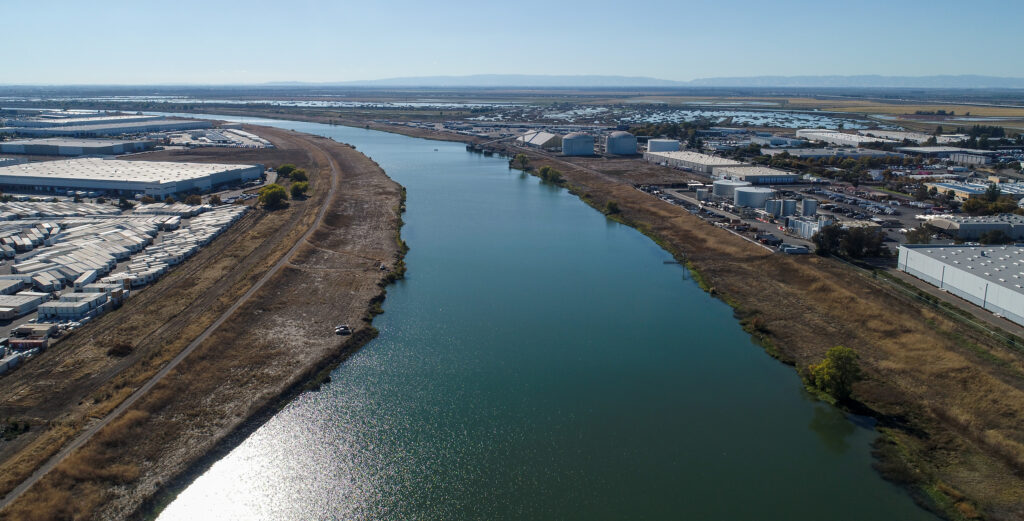The Abridged version:
- The long-planned Enterprise Bridge Project has implications for the Port of West Sacramento’s future.
- The project would provide a crossing to alleviate traffic to neighborhoods south of the port, but one of its potential designs could cut off ship traffic into the cargo operation.
- In response, the union that represents workers at the port’s cargo facility have filed a lawsuit against the city.
Tim Campbell remembers it being hot on his first day working at the Port of West Sacramento. At 17 years old, and no more than 130 pounds, he had been hired to load and unload 110-pound bags of rice making their way from California to markets as far flung as China and Vietnam.
The work was repetitive, and he spent his shift drenched in sweat as he lugged bag after bag up and down stairs. At the end of the day, his arms were rubbed raw by the burlap, an issue that one of the older workers fixed by cutting the ends off Campbell’s socks and pulling them over his forearms.
It wasn’t an easy job, but for a kid who didn’t see much more school in his future, it paid well.
“When I got my first paycheck, I was sold,” Campbell said.
Decades later, he is the president of the International Longshore and Warehouse Union Local 18, the division of the union that represents longshore workers at the Port of West Sacramento. Since he started in 1993, his father, sister and son have all come to work at the port.
“I’m a part of this place now, and it’s a part of me,” Campbell said.
But Campbell worries that this place is slipping away. One proposed project could mean the end of the port as he knows it.
The city of West Sacramento voted last year to move forward with plans to build a new bridge across the deep-water ship channel. The Enterprise Bridge Project is in its early design stages, but its potential existence has intensified a debate in West Sacramento about the role of the port, highlighting a tension in the city’s definition of itself. As residential developments boom and the riverfront transforms, the maritime industry — long central to life in the region — faces a far less certain future.

Bridge would increase access to growing neighborhoods
The proposed bridge would stretch over the Sacramento River Deep Water Ship Channel, just west of the cargo port. The move is intended to increase access to growing neighborhoods in the southern portion of the city, including Southport and Bridgeway Lakes. These neighborhoods are now mainly accessed by way of increasingly busy Jefferson and Lake Washington boulevards.
“We’ll be able to use this bridge and relieve traffic congestion,” said Aaron Laurel, West Sacramento’s city manager and CEO of the port.
That is likely years away, but the city cleared the way for a consulting firm to begin designing the crossing.
There are at least three designs being considered, two stationary and one moveable, according to a 2024 news release. One, the low fixed bridge, would likely be too short for large ships to pass through, effectively cutting off industrial scale cargo operations at the port.
This possibility so worried Campbell and his union that they filed a lawsuit against the city in June alleging that officials are attempting to scale back operations at the port in order to sell the land and replace industrial operations with residential development.
In Campbell’s eyes, the Enterprise project would be a culmination of that alleged effort. When he drives around the cargo port, he sees places where opportunities were missed to expand the operation’s business. There’s the food-grade rice silo that was taken permanently offline after what he said was a small hole chewed by a rodent. Nearby, places where large conveyor belts were used to move rice sit empty.
And bookending the port, chain link fences cut off large stretches of asphalt that were once part of the cargo operations but are now leased as parking lots for UPS and Walmart trucks.
“We’re watching this place wind down,” Campbell said.

A shifting strategy for West Sacramento’s financial future
In recent years, leasing, sale and development of the port’s landholdings have become important sources of revenue.
Laurel said that the port is the largest landowner in West Sacramento, so its operations should closely align with those of the city.
“The vision for each entity is very much, purposely, woven together. They’re symbiotic, and that’s how we’ve operated the port since it’s been under city control,” he said. The port has been under city control since 2006.
In Laurel’s eyes, that vision involves something more than just maritime operations at the cargo port.
“And that aligns with that objective to have the port be a real partner to the city,” he said.
The West Sacramento port, which has long served the rice and cement industries, transports less cargo than nearly every other major port in California, according to a study done by the Yolo Local Agency Formation Commission.
In 2020, the Port of Stockton did four times the amount of business than the Port of West Sacramento, which is inhibited by a deep-water ship channel that is too small for modern container ships. Since then, business in West Sacramento has remained fairly consistent, even as the Port of Stockton makes moves to become a hub of ship building on the West Coast.
For years, West Sacramento’s competitive disadvantage meant that it struggled financially. Laurel said that for the first seven years the port was under city control, it was a drain on resources.
“The potential for getting it out of its economic state was very dim,” he said.
That was part of the motivation for the city’s decision in 2013 to shift to a different strategy for managing the port. Instead of engaging in day-to-day operations of the entire port and contracting some services, the city and port commission decided to transition to a landlord model. By leasing the cargo terminal to SSA Marine and other pieces of land to outside contractors, the port has been able to diversify its revenue streams and fix what had previously been a shaky budget, Laurel said.
That has allowed the port to invest in the redevelopment of its real estate assets in a way that more closely aligns with the goals of the city. That includes development in waterfront areas of West Sacramento, much of which is owned by the port, Laurel said.
As the city continues to prioritize its growth, the focus of the port is shifting from an industrial maritime operation to a holder of large amounts of valuable land slated for development.

The port’s decision makers
Campbell worries that the port’s decision makers and city leaders have left him and his fellow longshore workers out of the conversation.
Despite being a separate legal entity from the city, the port commission’s five members are made up of four West Sacramento city council members and one Yolo County supervisor. Their monthly meetings are often scheduled to be held just before city council meetings, but, according to the city website, most have been cancelled this year.
This arrangement is unusual in California. At two larger northern California ports, Stockton and Oakland, none of the commissioners are council members or supervisors.
In spring 2024, the port commission contributed $1.35 million to the planning of the Enterprise project.
In an effort to get on the port commission, Campbell ran for a seat in 2024. After he lost by just over 500 votes, the union leader remained on the outside looking in.

Options for the bridge project
Laurel doesn’t view the Enterprise project in the same way as Campbell.
“Both things can be done simultaneously,” he said, referring to the bridge and cargo operation.
Laurel said decision makers have to consider all options, being conscious of cost. As it stands, the lower bridge design would be significantly less expensive to build.
But Laurel said the city is considering a tunnel option as well, which would preserve the cargo operation.
“The tunnel alternative is something that might make sense from a cost standpoint, even if it’s not the most ideal from a multi-mobile transportation perspective,” he said.
Beyond the cost, Laurel said, is “the importance to all parts of the city, not just in the vicinity of the crossing.”
The question is whether the needs of the industry, historically central to the West Sacramento’s identity, will move in step with those of a growing city. The answer may just come down to the height of a bridge.

Daniel Hennessy joins Abridged from the California Local News Fellowship. He’s a reporter covering Yolo County.
